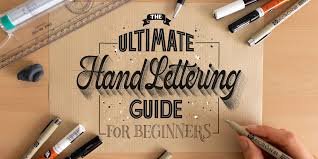
hand lettering
Hand lettering is an art form that has gained immense popularity in recent years. It is a form of drawing or writing where letters and words are written in creative styles. Every letter is designed uniquely, reflecting the creativity and personality of the writer. While hand lettering is an ancient art, it still holds a special place in today’s digital age. In this article, we will explore hand lettering, its techniques, tools, and its uses in various creative fields.
What is Hand Lettering?
Hand lettering refers to the act of writing letters by hand in an artistic manner. Unlike regular handwriting, hand lettering is all about designing each letter individually with specific shapes, styles, and decorations. It is often mistaken for calligraphy, but they are not the same. While both are written art forms, calligraphy is more about using special brushes or pens to create stylized scripts, whereas hand lettering allows for more creativity and freedom in the design of each individual letter.
Hand lettering involves choosing the right fonts, sizes, and spaces to create visually striking designs. When you write in hand lettering style, you aren’t just conveying a message; you are also creating an artistic expression.
The History of Hand Lettering
Hand lettering has been around for centuries. It traces its roots back to ancient civilizations, where people needed to write down their thoughts, ideas, and stories. Before the printing press, people manually wrote their documents. Many early forms of hand lettering can be found in medieval manuscripts and ancient scripts.
With the invention of the printing press, writing became much faster and more accessible, leading to a decline in the need for manual hand-lettering. However, in the modern era, hand lettering has been reintroduced as an art form. It has found its place in the creative industry, with designers using both traditional methods and digital tools to create new styles.
The Popularity of Hand Lettering
In recent years, hand lettering has become a widely embraced art form, particularly in crafts, DIY projects, and digital design. The rise of social media platforms like Instagram and Pinterest has played a significant role in the popularity of hand lettering. Artists and designers showcase their hand-lettered creations, inspiring others to try it out for themselves.
The beauty of hand lettering is that it can be applied in various creative areas. It is commonly used for greeting cards, posters, invitations, t-shirts, and home décor items. The personal touch that hand lettering adds is something that printed text simply cannot match. It creates a unique aesthetic that resonates with people on an emotional level.
Hand Lettering Techniques
Hand lettering offers a variety of techniques to explore and master. These techniques allow you to express your creativity in different ways. Some popular hand lettering styles include brush lettering, serif fonts, sans-serif fonts, and flourishes. Let’s dive into each one in more detail.
- Brush Lettering: This style of hand lettering uses brush pens and watercolor brushes to create thick and thin strokes that give each letter a fluid, bold appearance. The beauty of brush lettering lies in its ability to create varied stroke widths, giving the writing a dynamic and expressive quality. Brush pens like Tombow and Pentel are widely used for this style.
- Serif and Sans-Serif Fonts: Serif fonts are characterized by small decorative lines at the ends of letters, while sans-serif fonts do not have these extra strokes. Serif fonts are often seen as more traditional, while sans-serif fonts are cleaner and more modern. These fonts can be used to give your hand lettering a unique character and feel.
- Flourishes: Flourishes are decorative elements added to the letters, such as swirls or loops, to give the writing an elegant and ornate appearance. Flourishing is a great way to add style to your letters and make them stand out, but it’s important to use flourishes sparingly so they don’t overwhelm the design.
Tools for Hand Lettering
To create beautiful hand-lettered designs, you’ll need the right tools. These tools vary depending on your style and preference, but some essential hand lettering tools include:
- Brush Pens: Brush pens are flexible and versatile tools that allow for a wide range of strokes. Tombow and Pentel are popular brands known for their high-quality brush pens.
- Markers: Markers are often used for bold, thick strokes in hand lettering. They create consistent lines and are ideal for making big, bold designs.
- Pencils: Pencils are perfect for sketching your designs before committing to ink or markers. They give you the freedom to adjust the design as needed.
- Ruler: A ruler helps with spacing and alignment, especially if you want to create straight and even lettering.
- Paper: Paper selection is crucial. Smooth, thick paper is best when using ink or watercolor. You need paper that won’t bleed or warp under different types of pens and brushes.
The Benefits of Hand Lettering
Hand lettering isn’t just an artistic activity, it also provides several benefits. When you create designs with your hands, you are visualizing your thoughts, which can be a therapeutic process. It allows you to release stress and find a creative outlet. Here are some of the benefits of hand lettering:
- Boosts Creativity: Hand lettering challenges your mind and helps you think outside the box. It encourages you to experiment with different styles, making it a great creative exercise.
- Stress Relief: Research shows that engaging in creative activities like hand lettering helps reduce stress and improve mental well-being. Focusing on your design can calm your mind and allow you to relax.
- Improves Focus and Patience: Hand lettering requires attention to detail, which helps improve your focus and patience. These skills also transfer into other aspects of life, making you more disciplined and thoughtful in your approach.
Hand Lettering Uses
Hand lettering is used in various creative fields today. Whether it’s for personal or professional use, here are some of the common ways people incorporate hand lettering into their work:
- Event Invitations: Weddings and parties often feature hand-lettered invitations. The personal touch of hand lettering adds a unique, heartfelt element to any event.
- Home Decor: Hand-lettered quotes and messages are commonly used in home décor items like wall art, pillows, and framed prints. They add a modern yet personal touch to any living space.
- Stationery: Many people use hand lettering on their notebooks, journals, and planners. Adding a hand-lettered design to your stationery elevates its aesthetic and makes everyday items more special.
- Personalized Gifts: Hand lettering is a great way to create customized gifts, such as greeting cards, posters, and gift tags. Personalized hand-lettered gifts show that extra effort has been put into making the gift truly unique.






